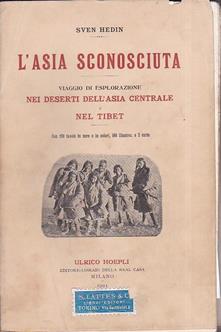 L'Asia sconosciuta
L'Asia sconosciuta

Reperibile solo nelle biblioteche.
Prima edizione italiana di questo resoconto viaggio compiuto in Asia Centrale e Tibet dal grande esploratore svedese fra il 1899 e il 1902.
La seconda spedizione in Asia centrale attraversò il bacino di Tarim, il Tibet e il Kashmir fino a Calcutta. Hedin navigò sui fiumi Yarkand, Tarim e Kaidu e trovò il letto del fiume secco del Kum-darja e il letto del lago prosciugato di Lop Nur. Vicino a Lop Nur, scoprì le rovine della antica città reale murata e successivamente città di guarnigione cinese di Loulan, contenente l'edificio in mattoni del comandante militare cinese, uno stupa e 19 abitazioni costruite in legno di pioppo. Ha anche trovato una ruota di legno da un carro trainato da cavalli (chiamato arabas) e diverse centinaia di documenti scritti su legno, carta e seta nella scrittura Kharosthi. Questi fornirono informazioni sulla storia della città di Loulan, che una volta era stata situata sulle rive del Lop Nur ma che era stata abbandonata intorno al 330 d.C. perché il lago si era seccato, privando gli abitanti dell'acqua potabile.
Durante i suoi viaggi nel 1900 e nel 1901 tentò invano di raggiungere la città di Lhasa, vietata agli europei. Continuò quindi per Leh (Ladakh) in India. Da Leh, il percorso di Hedin lo portò a Lahore, Delhi, Agra, Lucknow, Benares a Calcutta, incontrandosi lì con George Nathaniel Curzon, viceré dell'India.
Questa spedizione ha procurato 1.149 pagine di mappe, su cui Hedin ha raffigurato terre scoperte di recente. Fu il primo a descrivere le formazioni di Yardang nel deserto di Lop.
|
|
In 1899 the famous Swedish explorer, Sven Hedin, set out on one of his most hazardous journeys: to visit the little known interiors of Central Asia and Tibet. A three year voyage ensued amidst remote peoples and through inhospitable terrain. Hedin's goal was to penetrate the then forbidden city of Lhasa ... but the Tibetans had other ideas!
These two volumes contain a detailed account of Sven Hedin's journey of exploration in the first years of the century which took him through Chinese Turkestan and the Takla-Makan and Gobi deserts before he turned south into Tibet. He travelled through parts of northern Tibet and then attempted to reach Lhasa, only to be intercepted by Tibetan troops and turned back. He then turned south and travelled through to India via Ladakh. Although his prose style is sometimes hard going, his books are invariably rewarding; these two volumes contain over 400 illustrations, both line drawings and photographs, and several maps." |